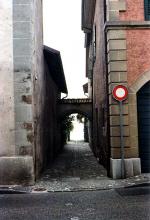|
Zeiss Ikon Ikonta (520/18 Lcr) |
Manufactured or assembled in Germany from 1935 to 1937.
Index of rarity in France: Infrequent (among non-specialized garage sales)
Inventory number: 3080
See the complete technical specifications
Chronology of cameras Zeiss Ikon
The small Ikonta is sometimes referred to as the "Baby Ikonta" or "Ikonta Miniature." It uses A8 film to produce 3 x 4 cm negatives and is incredibly compact, about the size of a cigarette case.
Here's what the Zeiss Ikon "advertisers" had to say about it in 1932:
"No bigger than a cigarette case, the Ikonta Miniature combines the ease of use of all Ikonta cameras with the well-known advantages of the 3 x 4 format. It's the ideal camera for capturing the thousand incidents of daily life and seizing interesting subjects instantly, without any preparations or calculations. It does not duplicate the larger, more advanced hand cameras, and it wonderfully complements the photographic equipment of the modern amateur.
With the Ikonta Miniature, as with all cameras in the family, various operations can be completed in seconds. Focusing is often unnecessary in good light, as all subjects are sharp with an aperture of 1:11, from a few meters to infinity.
All models of the Ikonta Miniature are equipped with high-aperture anastigmat lenses, known for their extreme sharpness, allowing for substantial enlargement, up to 18 x 24 at least.
It's a metal folding camera, covered with leather or imitation leather in the case of the more affordable versions (those with Novar lenses). The opening and activation are automatic. In other words, a simple press of the closing latch opens the bellows and positions it for use. It's worth noting that in practice, sometimes the bellows may need a little assistance to complete the last few degrees of opening.
There are numerous variations, combining different lenses (Novar or Tessar) and shutters (Derval, Telma, Compur, or Compur-Rapid). Here are some of them:"
| Code | Lens | Shutter |
|
|
||
| 520/18 E | Novar 6.3/5 cm | Derval |
| 520/18 I | Novar 4.5/5 cm | Derval |
| 520/18 IT | Novar 4.5/5 cm | Telma |
| 520/18 F | Novar 3.5/5 cm | Compur |
| 520/18 F | Novar 3.5/5 cm | Compur-Rapid |
| 520/18 U | Tessar 4.5/5 cm. | Compur |
| 520/18 L | Tessar 3.5/5 cm | Compur |
| 520/18 Lcr | Tessar 3.5/5 cm | Compur-Rapid |
__________
Il s'agit d'une version bien équipée du 520/18. La qualité et la robustesse de la grande majorité des produits Zeiss Ikon permettent facilement de considérer ce Baby Ikonta comme l'un des appareils sérieux les plus compacts de son époque.
Avec un Compur-Rapid (marqué Zeiss Ikon et non Deckel) et un Tessar, cet appareil a dû traîner dans bon nombre de poches, de sacs ou de musettes entre le moment de sa sortie et la fin de la deuxième guerre mondiale.
Le viseur à cadre pliant est simple et ne comprend pas de verre. En comparaison, un viseur Albada de haute qualité est monté sur le Super Ikonta A 531 (4½ x 6) légèrement plus tardif, par exemple.
Une indication de l'hyperfocale est portée sur la bague de mise au point (point rouge).
Sur cet appareil, le levier d'armement a été curieusement peint en bleu et celui du déclencheur en rouge. Curieux mais pratique.


Interesting links or bibliography :
Add a link or element of bibliography, a picture taken with this camera, a picture of box or an ads about this camera
Your photos taken with the same camera:
Cameras from Ebay France (Zeiss Ikon) (Uploaded each 3 hours)








